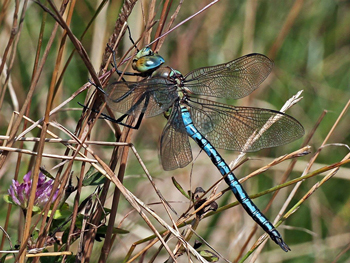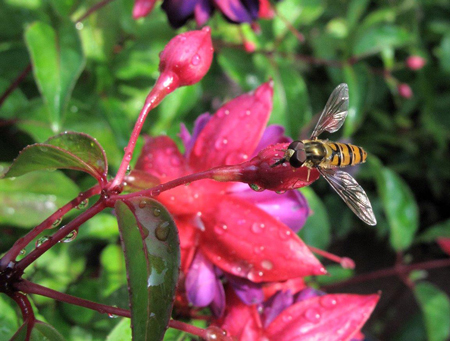You searched for:
“insect”
1. A type of very small, air-breathing creature with six legs, a body divided into three parts and usually two pairs of wings; or, more generally, any similar very small animal: "Ants, beetles, butterflies, and flies are all insects."
2. Any of numerous usually small arthropod animals of the class Insecta, having an adult stage characterized by three pairs of legs and a body segmented into head, thorax, and abdomen and usually having two pairs of wings. Insects include the flies, crickets, mosquitoes, beetles, butterflies, bees, and dragonflies.

2. Any of numerous usually small arthropod animals of the class Insecta, having an adult stage characterized by three pairs of legs and a body segmented into head, thorax, and abdomen and usually having two pairs of wings. Insects include the flies, crickets, mosquitoes, beetles, butterflies, bees, and dragonflies.

This is an example of an insect known as a dragonfly.
This entry is located in the following units:
insecto-, insect-, insecti- +
(page 1)
sec-, seg-, -sect, -section, -sectional
(page 2)
insectine: insect
Belonging to or characteristic of an insect.
This entry is located in the following units:
-ine
(page 10)
insecto-, insect-, insecti- +
(page 1)
sec-, seg-, -sect, -section, -sectional
(page 3)

A unit related to:
“insect”
(Greek: insect, bug; literally, "cut up, cut in pieces"; an insect because it appears to be segmented)
(Latin: a plant louse; a plant sucking insect)
(Special kinds of "flesh-eating" or insect-eating plants)
(utilizing insects to produce practical substances)
(Latin: a bug; literally, "cut into," from insectum, with a notched or divided body; literally, "that which is cut up, segmented" [as the bodies of the first invertebrates to which the term was applied or appeared to be])
(Latin: insect in its grub stage; from Latin larva, "mask" and by extension, "ghost", the idea being that an insect in its grub stage is merely a ghost of its future self and bears no resemblance to its future form)
(Old English: a small or tiny insect; acurus)
Word Entries containing the term:
“insect”
Insect Biotechnology
This entry is located in the following units:
bio-, bi-, -bia, -bial, -bian, -bion, -biont, -bius, -biosis, -bium, -biotic, -biotical
(page 41)
Information Technology (IT): Units Listed
(page 1)
insecto-, insect-, insecti- +
(page 1)
sec-, seg-, -sect, -section, -sectional
(page 2)
Word Entries at Get Words containing the term:
“insect”
Entomology or Insect Terms
- An Introduction to the Study of Insects by Donald J. Borror and Dwight M. DeLong; Holt, Rinehart and Winston; New York; 1964.
- General and Applied Entomology by V.A. Little; Harper & Row, Publishers; New York; 1957.
- Insects of the World by Anthony Wootton; Blandford Press Ltd.; New York; 1984.
- Spiders of the World by Rod & Ken Preston-Mafham; Facts on File Publications; New York; 1984.
- The Ant Realm by Ross F. Hutchins; Dodd, Mead & Company; New York; 1967.
- The Ants by Bert Holldobler and Edward O. Wilson; The Belknap Press of Harvard University Press; Cambridge, Massachusetts; 1990.
This entry is located in the following unit:
Bibliography or Lists of Glossary-Term Sources
(page 1)
Insect Gets Nectar from Flowers

Here is a hoverfly, also called a flower fly or a syrphid fly; which is part of the insect family Syrphidae and the adults of this group are often seen hovering or nectaring on flowers because they are known to feed primarily on nectar and pollen.
This entry is located in the following unit:
Views of Nature
(page 1)
insect society
In the strict sense, a colony of eusocial insects; such as, ants, termites, eusocial wasps, or bees.
In the broad sense, any group of presocial or eusocial insects.
This entry is located in the following unit:
Ant and Related Entomology Terms
(page 9)
insect sociobiology
The systematic study of all aspects of the biological basis of social behavior in insects.
This entry is located in the following unit:
Ant and Related Entomology Terms
(page 10)
social insect
In the strict sense, a true social insect is one that belongs to a eusocial species; in other words, it is an ant, a termite, or one of the eusocial wssps or bees.
In the broad sense, a social insect is one that belongs to either a pre-social or eusocial species.
This entry is located in the following unit:
Ant and Related Entomology Terms
(page 19)
